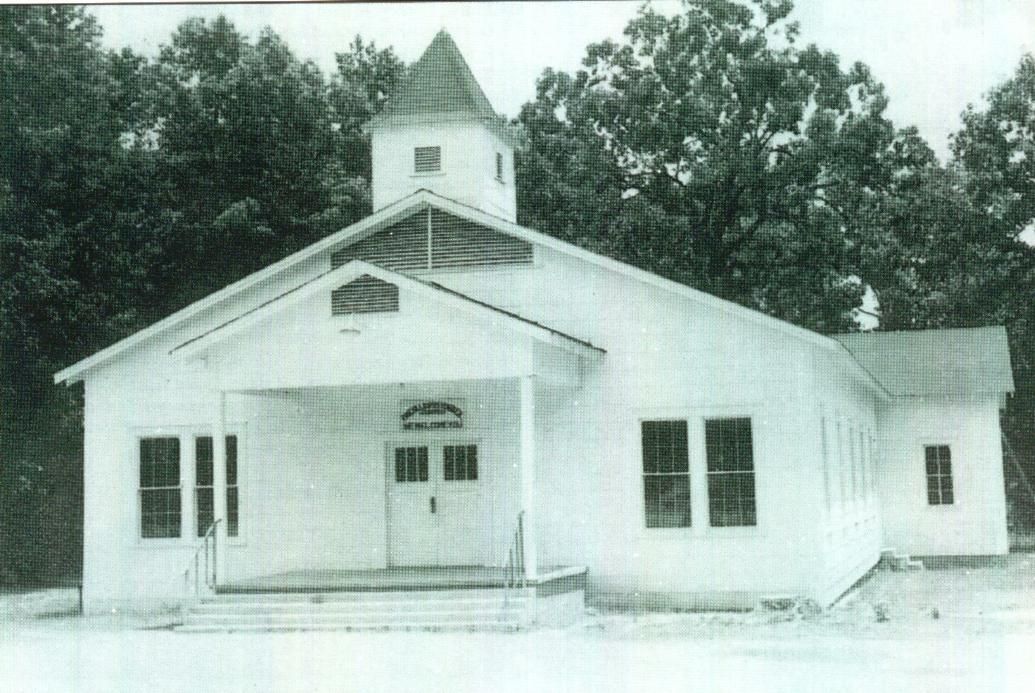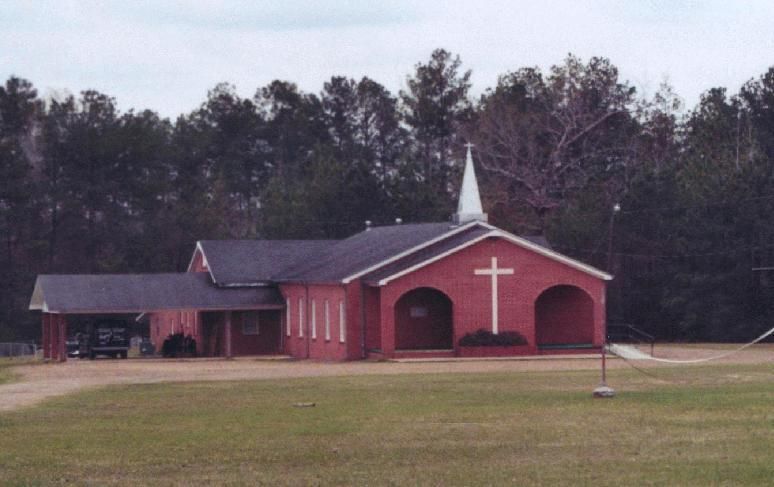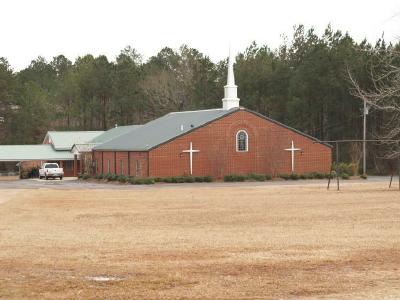

This was the next Building when the wooden church
was moved to the back for Sunday School Rooms.
 |
 |
This Pine Hill Church Building was Constructed in 1954 |
This was the next Building when the wooden church |

The following was taken from the microfilmed records of the church. The records were provided by The Pinehill Church.
The first moderator and organizer of the Pine Hill Baptist Church, Nathan M. Davis, and his assistant, M. Haggs, were residents of the Hemps Creek settlement which later became the town of Jena
They likely came because of a letter from C. P. Kees, the young Post Master of Castor Springs Post Office in 1860. M. N. Davis was one of the charter members of Old Salem Baptist, now Jena First Baptist Church, organized June 10, 1843. C. P. Kees, the first church clerk, sold his business in 1877 at Castor Springs to a man named Tom Haugh and he, with the help of S. S. Slemons, ran the store 4 years and sold out to Dr. Frank Mills. He ran the store and Post Office until it closed in 1893. C. P. Kees also had a store in front of the present Clinic in Urania in the late 1870’s and 1880’s. His wife was Martha Kees. His brother was J. W. Kees, the grandfather of Harper Kees. His wife was Sarah Kees.
Josiah Prestridge was born in 1832 and died in 1916 in Olla. He was believed to have been in the Civil War according to Church minutes as he signed the letter from the soldiers at Jackson, Mississippi, as their church clerk. His wife was Amanda Prestridge. His grandson, P. P. Prestridge, of Olla.
Frank M. Mills, one of the early members of Pine Hill Church, helped organize New Union Church in 1859, according to his own statement. He became a private in the Confederate Army, Co. F. 31st Louisiana Infantry. He enlisted at Jackson, Mississippi, May 4, 1862, captured at Vicksburg July 4, 1863. He was exchanged at Vienna, Louisiana, April 1, 1864 and discharged July 1, 1865.
He became a delegate to the Ouachita Baptist Association from Pine Hill in August 1865, thereby showing that he lost no time in getting back to the church work. He left Pine Hill Church about 1870 and became a member of New Union Church. He died in 1919.
Wylie P. Maxwell lived below the present town of Urania. He was reported to have been a veteran of the Civil War for a short time. He was the father of the late Charlie Maxwell. His lst wife was Fermeliar Maxwell.
“The first McCartney mentioned in the church minutes was F. S. McCartney who became a member in October 1860. He is likely the brother of Joe? and Charlie McCartney who became members of this church shortly after the Civil War closed.
Ervin E. and J. Manning Roberts were slave owners and held extensive lands from the present town of Olla to Urania before the war. They were father and son. Ervin E. fought for the confederacy and left his young son at home to take care of the slaves and farm. E. E. was the grandfather of Marcus Roberts and Manning, his father.
J. M. Mills was pastor at New Union 28 years. He preached there on the fourth Sundays in each month and at Pine Hill on the third, for several years. He lived at Little Creek in what is not LaSalle Parish.
Sam Patton, an early church member and slave owner lived near the present Olla Elementary School. He is listed as having two slaves, Joseph and Alfred. He was also the grandfather of Harper and Frank Kees. Perhaps these early slave owners had more slaves that were members of the Pine Hill Church.
Document 2, author and date unknown:
The Articles of Faith of the Ouachita Association was read and adopted by the Brethren and Sisters present as the Articles of Faith for this church. The Form of Church covenant received by the Ouachita Association was read and adopted. When the council saw no reason why they should not be constituted into a Church, the hand of fellowship was then extended first by the council, and then by the brethren and sisters to each other, and it was pronounced a regular constituted Baptist Church of Christ in the name of the Father, Son, And Holy Ghost.
On October 7, 1860 Rev. T. J. Humble was unanimously called as first pastor of the church.
The First church was a building of logs with the customary dirt chimney for heating and this building for many years was used as a school as well as a church
The second building was a box building with a flu and wood heater. It was 20 by 30 feet. Later 4 Sunday School rooms were added.
The minutes of the church show that these people maintained church services during the Civil war, which shortly disturbed the church by taking the young men to war. There was one letter recorded in the minutes from soldiers asking for their prayers for those located in camp near Jackson, Mississippi.
There were several slave owners members of this church who brought their slaves to the church. The slaves became members and continued as being listed as servants during the war and as blacks thereafter.
Blacks listed in October 1862:
George and Rachel servants of B. F. Anderson
Simon, Harett & Matilda Servants of E. E. & J. M. Roberts
Joseph & Alfred servants of Sam Patton
Filis servant of J. W. Kees
In early 1873 these Negroes were dismissed from the church going into a colored church.
There have been many pastors of this century old church which with its sister church New Union to the south were the only churches and schools located in this section of what was then Catahoula parish.
Protracted meetings usually lasted 10 days. The first one recorded in the minutes was September 29, 1867. The people came from miles around in wagon, on horse back, walking, but they came. There were 23 decisions at that first meeting. Bro. D. B. Thomas was the guest speaker along with Pastor T. J. Humble. The membership had grown from the original 11 to a total in October 1867 to 43 whites and 13 blacks.
The church had a regular conference each month. Before each session they always had a sermon, prayer, and song. They opened the doors of the church for the reception of new members and then took up necessary business.
According to the minutes in the year of 1869-1870 the offering for the church was $16.35. This amount was used for local expense with no mention of a pastor’s salary.
The people loved their pastor, though they only saw him once a month. Probably they paid him little but, listed in the minutes were contributions from the members to buy their pastor a horse. This was probably his mode of transportation to the church.
In the early years of the History of this church it had a rather rugged program of discipline for its members. Recorded in the minutes are occasions when the church withdrew its fellowship from members for quite a variety of sins. Some of there are—
Failing to attend church conference—profanity—dancing—intoxication—disagreement between members—firing a gun on the Sabbath—killing the hogs of another member and just plain unchristian conduct.
The church has been served by many pastors throughout the 100 years of its history. Some of these pastors were Br. T. J. Humble the first pastor, Bro. W. D. Ford, Bro. S. A. Lilly, Bro. J. M. Mills, Bro. A. Ferril, Bro. A. D. Grant, Bro. W. W. Dunn, Bro. A. D. McMurry, Bro. R. M. Doughty, Bro. J. J. Albritton, Bro. J. L. Holt, Bro. H. B. Bass, Bro. H. B. Stewart, Bro. G. G. Dyess, Bro. T. E. Windsor, Bro. T. T. Edwards, Bro. D. K. Harris, Bro. C. A. Green the present pastor. Several of these pastors have already taken leave of this world and have gone to be with the Lord, while others are still with us and serving God in several different places throughout the State of Louisiana.
On September 14, 1949 the church under the leadership of Rev. B. G. Dyess, voted to go into a full time church program.
On May 20, 1950 the church voted to build a new church building. Shortly thereafter construction was started on the present church. It was dedicated on Easter Sunday, April 18, 1954. A modern pastors home has also been completed and is located in the near by town of Olla.
There are several small cemeteries in various places around the church. You can walk through these small ones and also the large one across the road and read many interesting epitaphs and dates. You could find names of early members of the church some of which were charter members. These cemeteries are still being used today. Only recently one of the elderly deacons of the church was laid to rest here.
Document 3, author and date unknown:
HISTORY OF PINE HILL BAPTIST CHURCH
The Pine Hill Baptist church located between Olla and Urania was organized on September 22, 1860, with Rev. Nathan M. Davis serving as moderator. The early minutes of this Church were well kept by the first church clerk, C. P. Kees. He was known to have been the Post Master at the Castor Springs Post Office located on Castor Creek near the site of the present dam and the old Baptist encampment.
The following is an excerpt from the original minutes of the organization of the church:
September the 22, 1860.
The Brethren and Sisters met at the place here in after named and after sermon by Brother N. M. Davis and after minutes, recess was called. Council met consisting of Brethren M. Haggs and N. M. Davis and was received by the Brethren and Sisters present to aid them in organizing a church.
Bro. N. M. Davis was chosen moderator and Bro. C. P. Kees, Clerk. The following letters were received and read and the names enrolled:
C. P. Kees 1 Mary J. Hooker 10
J. L. McNeanas 2 Martha Kees 11
Josiah Prestridge 3
W. P. Maxwell 4
J. W. Kees 5
Ann McMeanas 6
Fermeliar A. Maxwell 7
Amanda Prestridge 8
Sarah A. Kees 9
The Articles of Faith of the Ouachita Association was read and adopted by the Brethren and Sisters present as the Articles of Faith for their church. The Form of Church Covenant received by the Ouachita Association was read and adopted. When the council saw no reason why they should not be constituted into a Church, the hand of fellowship was then extended first by the council, and then by the brethren and sisters to each other, and it was pronounced a regular constituted Baptist Church of Christ in the name of the Father, Son, and Holy Ghost.
On October 7, 1860, Rev. T. J. Humble was unanimously called as first pastor of the church.
The first church was a building of logs with the customary dirt chimney for heating and this building for many years was used as a school as well as a church.
The second building was a box building with a flu and wood heater. It was 20 by 30 feet. Later four Sunday School rooms were added.
The minutes of the church show that these people maintained church services during the Civil War, which shortly disturbed the church by taking the young men to war. There was one letter recorded in the minutes from soldiers asking for their prayers for those located in camp near Jackson, Mississippi.
There were several slave owners members of this church who brought their slaves to the church. The slaves became members and continued as being listed as servants during the war and as blacks thereafter.
Blacks listed in October, 1862: George and Rachel, servants of B. F. Anderson; Simon, Harett & Matilda, servants of E. E. & J. M. Roberts; Joseph & Alfred, servants of Sam Patton; Filis, servant of J. W. Kees.
In early 1873 these Negroes were dismissed from the church going into a colored church.
There have been many pastors of this century old church which with its sister church New Union, to the south, were the only churches and schools located in this section of what was then Catahoula Parish.
Protracted meetings usually lasted 10 days. The first one recorded in the minutes was September 29, 1867. The people came from miles around in wagons, on horse back, walking, but they came. There were twenty-three decisions at that first meeting. Bro. D. B. Thomas was the guest speaker along with pastor T. J. Humble. The membership had grown from the original eleven to a total in October `867 to forty-three whites and 13 blacks.
The church had a regular conference each month. Before each session they always had a sermon, prayer, and song. They opened the doors of the church for the reception of new members and then took up necessary business.
According to the minutes in the year of 1869-1870, the offering for the church was $16.35. This amount was used for local expense with no mention of a pastor’s salary.
The people loved their pastor, though they only saw him once a month. Probably they paid him little but, listed in the minutes were contributions from the members to buy their pastor a horse. This was probably his mode of transportation to the church.
In the early yeas of the History of this church it had a rather rugged program of discipline for its members. Recorded in the minutes are occasions when the church withdrew its fellowship from members for quite a variety of sins. Some of these were: Failing to attend church conference, profanity, dancing, intoxication, disagreement between members, firing a gun on the Sabbath, killing the hogs of another member and just plain unchristian conduct.
The Church has been served by many pastors throughout the 100 years of its history. Some of these pastors were Bro. T. J. Humble, the first pastor, Bro. W. D. Ford, Bro. S. A. Lilly, Bro. J. M. Mills, Bro. A. Ferril, Bro. A. D. Grant, Bro. W. W. Dunn, Bro. A. D. McMurry, Bro. R. M. Doughty, Bro. J. J. Albritton, Bro. J. L. Holt, Bro. H. B. Bass, Bro. H. B. Stewart, Bro. B. G. Dyess, Bro. T. E. Windsor, Bro. T. T. Edwards, Bro. D. K. Harris, and Bro. C. A. Green, the present pastor. Several of these pastors have already taken leave of this world and have gone to be with the Lord, while others are still with us and serving God in several different places throughout the State of Louisiana.
Pm Se[te,ber 14. 1949, the church, under the leadership of Rev. B. G. Dyess, voted to go into a full time church program. On May 20, 1950 the church voted to build a new church building. Shortly thereafter construction was started on the present church. It was dedicated on Easter Sunday, April 18, 1964. A modern pastors home hs also been completed and is located in the nearby town of Olla, La.
There are several small cemeteries in various places around the church. You can walk through these small ones and also the large one across the road and read many interesting epitaphs and dates. You could find names of earily members of the church some of which were charter members. These cemeteries are still being used today. Only recently one of the elderly deacons of the church was laid to rest here.
The church has a present membership of 221, with 107 enrolled in Sunday School and 64 enrolled in Training Union. Pine Hill Church continues to have a full time church program with services on Sunday morning and evening and on Wednesday evening with some organizations meeting at other times during the week. We covet your prayers that the Pine Hill Baptist Church might continue to be a living, vital witness for our Lord and Saviour Jesus Christ until that hour when He shall return in the air to take His own out of this world.
Located at 31-53-01N and 92-15-47W
Most if not all of the male charter members served the Confederacy during the War Between the States, Wiley P. Maxwell was 1st. Lieutenant with the 4th. Regt. LA Cav., CSA. His brother in law, Commodore Perry Kees was a Private in the same unit. Others served in the 31st. LA Infantry. My ggg grandfather, Elvington E. Roberts who had extensive land holdings northwest of the present town of Urania was, according to the church minutes, away in the service of the Confederacy but I have searched the records in Boothe’s listing of officers and soldiers and he isn’t mentioned. As he was around 70 years of age at the time, I can only surmise that he was serving in some civilian capacity, possibly concerning transportation or other non military duties. In passing, I will mention that two of my g grandfathers, Richard M. Cook and Henry Cook served in the 28th. LA Infantry and 8th. LA Infantry respectively. Grandfather Henry was wounded at the Battle of Gettysburg but survived.
E. Forrest Cook